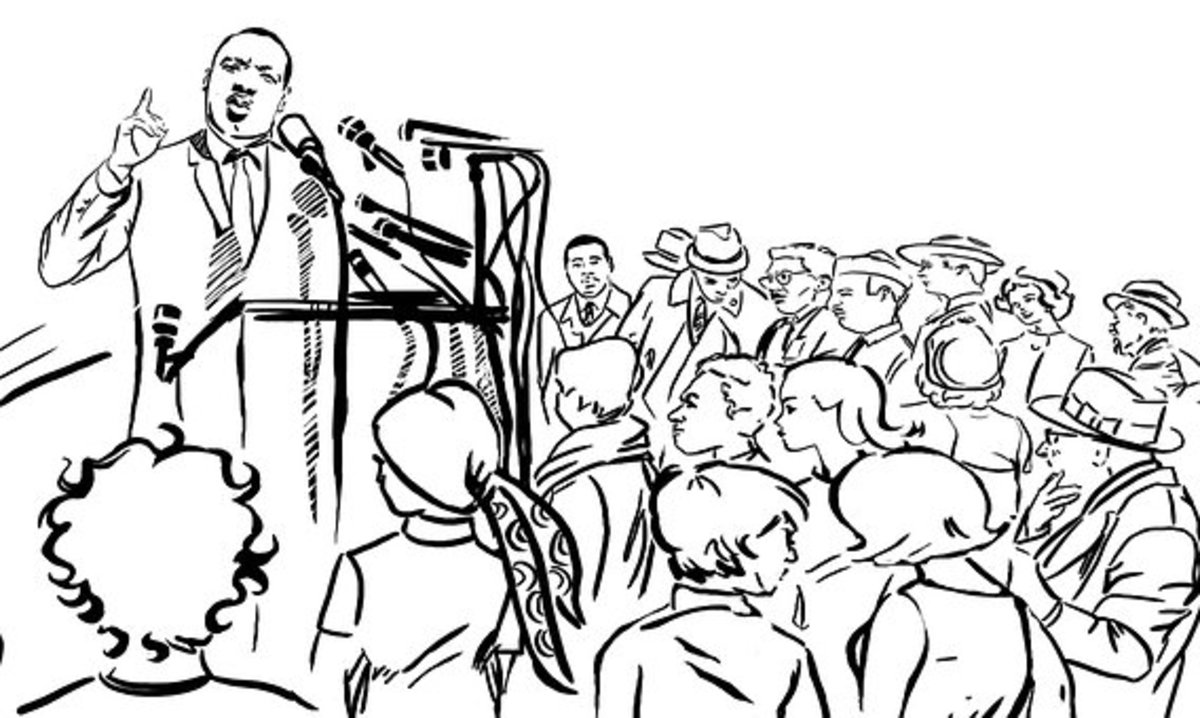Barack Obama's different accents

1. Introduction
Politicians are expert public speakers, whose jobs often involve the use of rhetoric in order to persuade the public of a particular notion, or in the case of an election campaign, of speakers’ fitness for the job. Political speeches are littered with rhetorical devices: consider Abraham Lincoln’s repetition in “of the people, by the people, for the people”, and alliteration in John F. Kennedy’s “lead the land we love” and Winston Churchill’s “dull, drilled, docile, brutish masses”. Rhetorical devices alone, however, seldom suffice, and political speakers may employ other linguistic processes, in addition to rhetoric. One such process that has been observed in political speech is linguistic style-shifting. A politician will utilise style-shifting in order to align themselves with an audience, with the ultimate aim being that the audience feel more able to identify with and more easily relate to the speaker. Style-shifting in politics often goes unnoticed, but a number of cases have been covered in the press, with Hillary Clinton (Dowling 2007), George Osborne (Ensor 2013), plus several others, being subjects of articles about changing/phony accents.
The aim of this study is to investigate the extent to which the current president of the United States, Barack Obama, employs style-shifting. More specifically, the study concerns itself with examining a switch in Obama’s speech, from Standard American English/General American (GA) to African American Vernacular English (AAVE). Based on past research and theoretical framework on linguistic accommodation, the investigation looks at Obama’s use of AAVE speech features in speech addressing a black audience, compared to speech addressing a non-black audience.
The study follows this agenda: the remainder of section 1 sets out the hypotheses to be tested, and also defines and exemplifies the three AAVE speech features that the study concerns itself with. These three features are part of a longer list of AAVE speech features, supplied in order to provide a fuller description of the dialect under examination. Section 2 is dedicated to contextualising the study, by offering a number of previous research and observations regarding style-shifting in politics in general, plus a more specific look at Dick Gregory and Stokely Carmichael’s style-shifting to AAVE when addressing black audiences, with reference to Ervin-Tripp (2001). The Communication Accommodation Theory proposed by Giles (2008) is also explained and made relevant to the topic of Obama and AAVE. This theory is later drawn on in order to explain the results yielded from the investigation. The work of Detert et al. (2003) is also considered. The scholars here suggest future research on Obama’s use of AAVE should make use of a sound-processing program in order to yield more reliable results, and also comment on a number of other methodological issues encountered in their research. The study carried out here is compared to that of Detert et al., in terms of outlining their shortcomings and discussing how this study has improved upon them. Methodology is detailed in section 3, with sub-sections on the data sources, computer programs used, and methodological issues encountered. Section 4 involves a presentation and discussion of results, looking firstly at Obama’s overall use of AAVE speech features when addressing black audiences compared to non-black audiences, and secondly looking at whether his style-shifting to this dialect has changed at all over time, using pre-election and post-election as the time-points to compare. Following the results, there is a discussion and conclusion summarising the study, the results (along with an explanation) and what can be drawn from them, and whether they are in line with the majority of previous research and relevant theories discussed in section 2.

1.1. Hypotheses
This investigation aims to answer the following questions: firstly, does Barack Obama style-shift to AAVE when addressing an African American audience? Secondly, does Obama use more or less AAVE features in his speech now, since having been elected president? From these questions, the following hypotheses have been drawn:
- Hypothesis 1: Obama will use more AAVE speech features when addressing a black audience than when addressing a non-black audience. In other words, style-shifting will be observed.
- Hypothesis 2: AAVE speech features will be less common in Obama’s post-election speech, than his pre-election speech. He will use less AAVE speech features now, as president, than before he was elected.
1.2. The AAVE speech features
1.1. The AAVE speech features
The study of style-shifting in speech typically involves quantitative analysis of phonological variables (Coupland 1985: 153), and this is no different here. Phonological features noted in literature as being indexical of AAVE include: the reduction of word-final consonant clusters (Biasibetti et al. ND; Charity 2008), consonant metathesis (Rickford 1999), r-deletion (Charity 2008), monophthongization of diphthongs (Biasibetti et al. ND; Charity 2008), [ɪŋ] as [ɪn] in gerunds and participles (also referred to as (ING) variation) (Biasibetti et al. ND; Charity 2008; Rickford 1999), l-deletion (Charity 2008) and more. The AAVE speech features to be analysed within this study are outlined in Table 1 below.
GA
| AAVE
| |
|---|---|---|
(ING) gerund suffix variation
| ɪŋ
| ɪn
|
r-deletion
| fɑːðər
| fɑːðə
|
Lax HAPPY vowel
| hæpi
| hæpI/hæpɛ
|
The analysed speech features with their GA and AAVE IPA transcriptions.
There is ample support as regard the [ɪn] gerund suffix and r-deletion being indexical of AAVE. However there is a significant lack of evidential support for the lax HAPPY vowel as being distinctive of AAVE. Sub-sections 1.3, 1.4 and 1.5 cover each of the analysed variables independently.
1.3. [ɪn] gerund suffix
(ING) variation is widely supported in literature, is ubiquitous in varieties of English (Chambers 2003) and has been studied by countless linguists, Labov et al. (2006), Tagliamonte (2004) and Trudgill (1972), to name but a few. Factors affecting the variable reportedly include formality, social class and speaker style (Labov 2001). Regarding the variable in AAVE, Kendall (2008) acknowledges that it is best summarised by Green (2002: 121): ‘ng […] in the -ing suffix is realized as n in most contexts’. Previous studies with a focus on the titular dialect have found 62% use of [ɪn] rather than [ɪŋ] by AAVE-speaking New Yorkers, and for ‘out-of-towners’ this increased to 77% (Labov et al. 2006: 257). This can be interpreted as convergence by the out-of-towners to the speech of the New Yorkers. Although the subjects of this study were all AAVE speakers, it does imply that the speech feature is susceptible to the effects of accommodation. From this, it can be expected that Obama’s (ING) will also be susceptible.
1.4. r-deletion
Thomas (2007: 453-454) provides a detailed description of /r/ in American English. He states that AAVE usually involves r-deletion to some degree, but also that it has been declining in European American. Importantly, African Americans exhibit a greater frequency of r-deletion than European Americans (Labov et al. 1968; Myhill 1988; Williamson 1968; Wolfram and Thomas 2002). In a style-shift from GA to AAVE then, Obama should be expected to adopt a noticeable degree of r-deletion. Note however, that r-deletion in AAVE is more common ‘in unstressed syllables, […] and in final and preconsonantal postvocalic positions’ (Thomas 2007: 453).
1.5. Lax HAPPY as indexical of AAVE
HAPPY-tensing (Fabricius 2002; Wells 1982) is the pronunciation of words with orthographical word-final –y, such as happy, as /hæpi/ (with a tense [i]), and is considered by some to be part of the phonology of RP and GA (Harrington 2006; Lee 2009; Trudgill 2001: 7). However it is known not to occur in AAVE (Lee 2009). On the other hand, a lax HAPPY vowel (the [I] in /hæpI/), is viewed as a characteristic of AAVE (Detert et al. 2013; Lee 2009). In this study, Obama’s avoidance of HAPPY-tensing and preference for a lax HAPPY vowel can therefore be considered as divergence from GA and a style-shift to AAVE.
2. Background research and literature
The following section provides a variety of previous research in to style-shifting and AAVE. This research ranges from observations made regarding Obama’s use of AAVE, to the style-shifting to AAVE of other politically active, black Americans, to a theoretical framework which can be applied in order to explain a speaker’s motivation for style-shifting, namely Communication Accommodation Theory.
2.1. Obama and AAVE
Barack Obama is known to use both GA and AAVE. Holliday (2014) conducted an investigation in to Obama’s rate of coronal stop deletion, and questions whether this feature is used as a stylistic variable when speaking to a black audience. Alim and Smitherman (2012) note Obama’s tendency to use AAVE phonology when addressing black audiences, for example “nah, we straight”, used in Washington toward a black cashier. According to Johnstone (2009), this in order to represent his membership of the African-American community. Furthermore Alim and Smitherman’s research has shown that Obama’s style-shifting from GA to AAVE is of public knowledge, with 93% of survey respondents claiming they were aware of it and had observed Obama’s drifting between the two.
2.2. Stokely Carmichael, Dick Gregory and AAVE
Style-shifting in politics has been discussed in detail in literature, and is regarded by some as a key political strategy (Hall-Lew et al. 2012; Heller 1992). According to Ervin-Tripp (2001), style-shifting can be induced in the speaker by the addressee and can be regarded as a result of the effect of linguistic accommodation. In other words, Ervin-Tripp assumes that accommodation leads a speaker to either converge with or diverge from an addressee, initiating a style-shift either toward or away from the dialect of the intended direct audience of the speech.
Furthermore, Ervin-Tripp conducted a study in to the use of style-shifting of two politically active, black Americans and found results very relevant to this study. Stokely Carmichael (former chair of the Student Non-violent Coordinating Committee) reportedly shifted to AAVE when making a major point directed toward a black audience (2001: 48). Dick Gregory ran for president in 1968, and his speech at the time yielded 32% r-deletion, 54% consonant cluster reduction and 47% copula deletion. At an older age, his use of AAVE features had reduced: 5% r-deletion, 26% cluster reduction and 1 occurrence of copula deletion. Also note that AAVE feature frequency apparently increased with the more ‘radical political message[s]’ (Ervin Tripp 2001: 52). These findings inform the hypotheses to be tested here: Carmichael’s style-shifting to AAVE to address a black audience indicates convergence and suggests Obama will be shown to do the same, and Gregory’s decrease in AAVE feature use over time supports the hypothesis that Obama’s style-shifting to AAVE will occur to a lesser extent in post-election speech.
2.3. Communication Accommodation Theory
Communication Accommodation Theory (CAT) (Giles 2008) can be applied in order to explain a speaker’s motivation for style-shifting. CAT is based on linguistic accommodation, which can be interpreted as a speaker’s attempt ‘to modify his persona in order to make it more acceptable’ to the addressee (Giles & Powesland 1975: 158). Essentially, the speaker is driven by a desire for the social approval of the addressee. Linguistic accommodation can be considered as part of a wider process (which involves modification of intonation, body language and more), whose aim is to reinforce and present to others what in-group the speaker identifies with. In-groups are defined as ‘a social category or group with which you identify strongly’ (Giles 2013: 142). By presenting oneself as identifying with the in-group of the addressee, the speaker instantly appears more similar to them, and thus it is more likely that the addressee will be attracted to them, according to Giles and Smith’s proposition of similarity attraction (1979). Additionally, Giles and Smith (1979) also note that the extent to which a speaker converges with an addressee correlates with their need for social approval. Ergo the greater the need for approval, the stronger/more frequent the convergence. Applied to Obama shifting to AAVE, CAT offers a simple explanation in terms of a speaker motivated by the approval of his audience – likely a common scenario for all politicians. Obama will seek to present himself as part of the African American in-group, in order to gain the social approval of a black audience. This will involve a style-shift to AAVE.
2.4. A response to Detert et al. 2013
Detert et al. (2013) likewise conducted an examination of Obama’s style-shifting to AAVE. In their work they discuss some of the methodological issues they encountered and provide suggestions for future research. The study detailed in this essay has taken the comments of Detert et al. in to account, aiming primarily to improve on their methodology, and secondly to widen the scope of study, as suggested. Firstly, Detert et al. commented on the limitations of their results due to the use of only 4 recordings as data source. In response, this study uses 7 recordings as data source; although still limited, it is certainly an improvement. Secondly, Detert et al. proposed that the use of a sound-processing program in future studies would increase the reliability of results. In their study, changes were detected by ear, which does not limit the possibility for human error. In this study, the sound-processing program FAVE has been used extensively in order to limit the possibility for human error. Finally, Detert et al. imply Obama’s AAVE feature usage may have become more frequent since having been elected president, and suggest a temporal focus to future analysis. Although this study concerns itself chiefly with the extent to which Obama uses AAVE toward black audiences, there is also a secondary temporal analysis, grouping recordings in to pre-election and post-election groups and conducting a comparison between the two. By acting on the comments of Detert et al, this study can be considered as a response to their 2013 study on Obama and his style-shifting to AAVE.

3.1. Compiling the data source using YouTube recordings
Recordings were all found on the video sharing website, YouTube. The temporal and contextual factors taken in to account when deciding which recordings to use, were: when the speech was given (in terms of pre-/post- election) and the ethnicity of the audience (black or non-black). The recordings used are intended to represent both pre- and post- election and both black and non-black audiences. Analysing recordings from both pre- and post- election, as well as when Obama is addressing black and non-black audiences, allows a comparison of style-shifting across time. The results should allow insight in to whether Obama does in fact use AAVE speech features when addressing black audiences, as well as whether this style-shifting is more or less prominent since having been elected president. Recordings are listed and described below. (For reference: Obama was elected as President on November 4th 2008 and re-elected for a second term on November 6th 2012.) Table 2 provides details of the analysed recordings in terms of the audience ethnicity, and under which temporal variant each recording falls.
Recording 1: National Association for the Advancement of Colored People, 2007.
Recording 2: Voting Rights march Commemoration Speech, Selma, Alabama, 2007.
Recording 3: National Association for the Advancement of Colored People, 100th Anniversary, 2009.
Recording 4: Congressional Black Caucus Dinner, 2011.
Recording 5: ‘Yes We Can’ speech, Nashua, New Hampshire, 2008.
Recording 6: Addressing the nation on ISIL, 2014.
Recording 7: Jimmy Kimmel live, 2015.
Recording Number
| Audience Ethnicity
| Pre-/Post-Election
|
|---|---|---|
1
| Black
| Pre-Election
|
2
| Black
| Pre-Election
|
3
| Black
| Post-Election
|
4
| Black
| Post-Election
|
5
| Non-Black
| Pre-Election
|
6
| Non-Black
| Post-Election
|
7
| Non-Black
| Post-Election
|
Details of recordings: Audience ethnicity and pre-/post-election.
In summary: Recordings 1-4 are speeches addressing black audiences, while recordings 5-7 are speeches that are not addressing black audiences, e.g. addressing the nation as a whole. There are three pre-election speeches and four post-election speeches. Note that the speeches in recordings 6 and 7 occurred after Obama’s re-election. While this study does indeed investigate AAVE feature use post-election, it does not take post-re-election as its own group of recordings. Instead, recordings 6 and 7 are placed within the post-election group.
3.2. ELAN transcriptions
Recordings were ripped in to .wav files in order to make them compatible with ELAN. Where relevant, interviewer, noise and audience annotation tiers were created in addition to the Obama annotation tier. Non-standard forms were transcribed in to English standard forms, for example complainin’ was transcribed as complaining. Note that ELAN does not have the ability to ‘detect phonetic differences’ (Detert et al. 2013: 7), so files were exported in to text grids, to be used with the sound-processing program, FAVE-align.
3.3. FAVE-align
For each recording, the .wav file and corresponding text grid, as exported from ELAN, were uploaded. The FAVE-align then ran and returned an email with a list of unrecognisable words. This list comprised of misspelled words and nouns that were not a part of the FAVE-align inventory, and included words such as emphasise, tweets and Obama. Note that FAVE-align’s inventory is based on American English spelling (- the software was created by the University of Pennsylvania). Words whose spelling varies from British English to American English, and had been transcribed according to their British spellings, consequently posed a minor problem for FAVE-align. These words included emphasise/emphasize, recognise/recognize, organiser/organizer and more. This issue was overcome by simply changing the English spelling to the American spelling in the text grids. Other unrecognisable words include recent technology-based neologisms such as smartphones and tweets, and proper nouns including Barack, Obama and Qaeda. The neologisms and proper nouns that were correctly spelt, but were still not recognised by FAVE-align, had to be manually transcribed in to ARPAbet form, which is the phonetic alphabet used in FAVE, and can be considered similar to IPA. The ARPAbet is provided in the Appendix, for convenience. The process of transcription in to ARPAbet is outlined below:
- Search lexical item on Oxford Dictionary online
- Note IPA transcription
- Translate IPA in to ARPAbet using FAVE guidelines
- Re-upload .wav and text grid, along with extra ARPAbet translation file
3.4. Praat and coding
From each .wav and text grid pair, FAVE-align produces a phonetically-aligned file for use with Praat. The three analysed variables were coded for in all of the FAVE-aligned files, and the frequencies of each noted.
3.5. Methodological issues
The methodology was planned out using that of Detert et al. (2013) as a basis. Improving on Detert et al., the data source comprises 7 recordings of Obama, the analysis involves the use of a sound-processing program, namely FAVE-align, and there is an added temporal focus to analysis. However, methodological issues were not entirely eliminated. Although 7 recordings is certainly an improvement on the 4 of Detert et al., this is still not a sample that can be considered fully representative of Obama’s speech as a whole. The recordings are all political speeches and consequently results do not provide insight in to Obama’s informal speech. This is a key issue, as it may be the case that Obama style-shifts to AAVE even more so in informal speech, as observed by Alim and Smitherman (2012). Also note that FAVE-align is a relatively new sound-processing program, which may come with its own faults. However, the use of this program has limited the possibility of human error, which was a major issue for Detert et al.
4. Presentation of results
Results have been tabulated to provide an overview of the difference between Obama’s use of AAVE features in speech addressing black and non-black audiences. This overview can be seen in Figure 1. Results for each of the analysed variables are also presented independently. Following this, the results of the temporal analysis are presented and discussed.
4.1. Overview of results
Figure 1, below, delivers insight in to the difference in Obama’s speech when addressing a black audience in comparison to a non-black audience. The figures in Figure 1 are averages of the usage rates of the three analysed features.
Black
| 31%
|
Non-Black
| 6%
|
Obama’s average use of AAVE speech features when addressing black and non-black audiences.
It is quite clear that Obama does shift his speech to AAVE to a certain extent, and that the audience addressed is a factor in this. There is a 25% increase in AAVE feature use from when the addressee is non-black, to when the addressee is black. The proposition that speech style is designed for an audience (Bell 1984: 159; 2002: 143) is heavily supported, as the audience is shown here to be a major factor in the use of style-shifting. In the sections that follow, the difference between Obama’s speech addressing black and non-black audiences is investigated in more depth.
Black
| Non-Black
| |
|---|---|---|
r-deletion
| 8% (N=103)
| 1% (N=157)
|
Lax HAPPY
| 70% (N=46)
| 7% (N=67)
|
[ɪn] gerund suffix
| 60% (N=20)
| 28% (N=29)
|
A table to show Obama’s use of AAVE features in speech addressing black and non-black audiences.

More Hubs about Linguistics
Check out these awesome hubs for more linguistics, experiments, observations and more!








